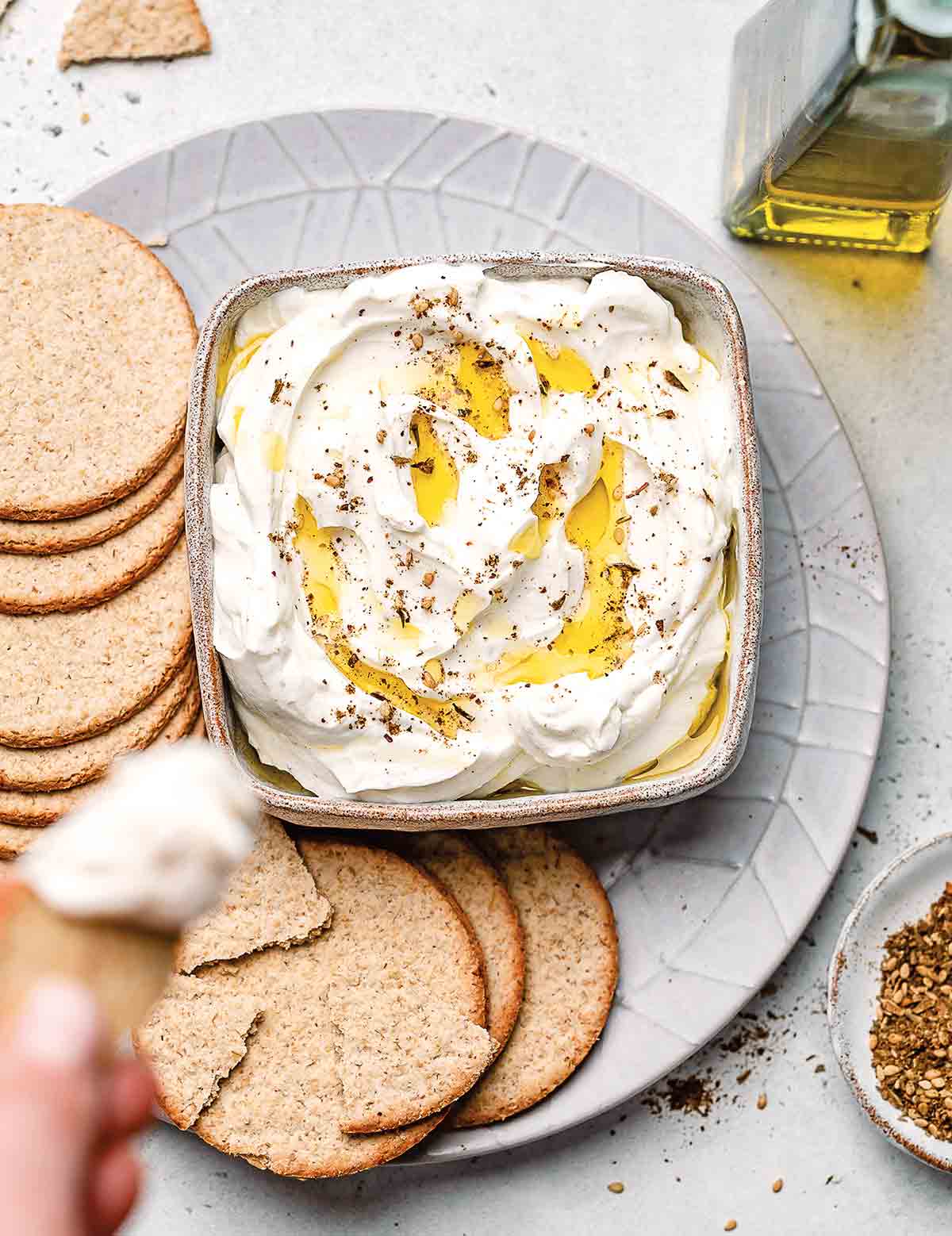
This refreshingly smooth and creamy cheese offsets the zesty spice blend and makes an optimal spread for bread or crackers. Notes of hearty herbs such as oregano and thyme provide intense aromas, while toasted sesame seeds add nuttiness and crunch. A possible side effect includes ingesting leftovers by the spoonful for a midnight snack. It’s made from yogurt, so no shame is necessary, right? The labneh can be spread on toast for breakfast, served with crackers as an appetizer, or with warm pita bread on a mezze platter.–Mihaela Mitaxa-Albu
What is labneh?
Labneh is made by straining excess liquid from full-fat yogurt, resulting in a thick, ultra-creamy spreadable cheese. Fresh cheeses such as labneh are tangy and extra creamy, similar to crème fraîche. The clean, fresh flavors make them the perfect vessel for your favorite flavorings. Labneh can also be made without the za’atar, making it an excellent replacement for any recipe that uses cream cheese or ricotta.
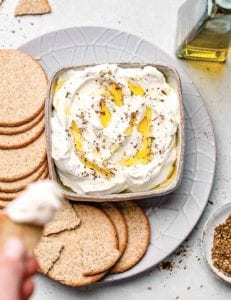
Homemade Labneh with Za’atar
Equipment
- Middle Eastern Cheesecloth
Ingredients
For the labneh
- 24 ounces store-bought or homemade plain whole milk yogurt, without any additives or flavors
For the za’atar seasoning
- 1/2 tablespoon dried oregano
- 1 tablespoon ground thyme
- 1 tablespoon sumac
- 1 tablespoon toasted sesame seeds
- 2 teaspoons dried marjoram
- 1 teaspoon fine kosher salt
- 1/2 teaspoon freshly ground black pepper
- Extra virgin olive oil for drizzling
Instructions
Make the labneh
- Line a strainer with a double layer of cheesecloth, covering all sides. Place the strainer on a large bowl for draining.
- Pour the yogurt into the strainer. Bring together the sides of the cheesecloth and twist them tightly around the yogurt. Place a small plate on top of the bundle and weigh it down using a heavy can or similar object.
☞ TESTER TIP: Use a twist tie to secure the cheesecloth in order to keep it nice and tight.
- Refrigerate for 12 to 24 hours, checking the bowl and draining the whey occasionally so that the strainer isn’t resting in any liquid. The longer you let it drain, the thicker the cheese will become. After draining, the labneh will be thick and spreadable, like a soft cream cheese.
- When the draining is complete, give the cheesecloth one last squeeze to remove any lingering whey, then remove the labneh from the cheese-cloth and discard the whey left in the bowl.
- In a medium bowl, add the labneh and use a spatula to stir to remove the cloth markings and to make it nice and creamy.
Make the za’atar seasoning
- In a small bowl, combine all za’atar ingredients and mix well.
Serve the labneh with za'atar
- Drizzle the labneh with the olive oil and sprinkle with the za'atar to taste.

Nutrition
Nutrition information is automatically calculated, so should only be used as an approximation.
Recipe Testers’ Reviews
I adore labneh on everything – sumac chicken, bagels, in salads and as a dip. Unfortunately, it’s hard to find here and I was thrilled to find this homemade labneh with za’atar recipe. It’s SO easy to make and turned out perfectly.
I used my favorite brand of whole milk yogurt and after straining for 24 hours, most of the whey had been forced out. I used a triple thickness of cheesecloth, twisted and bound the loose ends tightly, then placed under a weight. I gave it one last squeeze before emptying the cheesecloth and that seemed to purge the last of the whey.
At this point, it was the right texture. I added the oil and za’atar, stirring to combine. I prefer this to just sprinkling the herbs on top; I find that the moisture of the cheese makes the flavors stand out even more. After sitting in the fridge for a few hours, I served it with grilled chicken, pitas and cucumbers. And I still had more than enough for the next morning’s bagels.
When the most difficult component of a recipe is owning cheesecloth, there’s no reason not to try it. Having made the other labneh recipe from the site, I had high hopes for this one and I was not disappointed. Your patience is rewarded with a lusciously smooth cheese with no preservatives, stabilizers, or off-tastes and you can season it any which way you choose.
Depending on the size of the gap between the bottom of your bowl and your strainer, you may need to dump the liquid out once or twice to make sure it doesn’t sit in its own liquid. The included za’atar recipe is quite good, with a nice lemony tartness from the sumac, and I used 3 tablespoons worth to season my cheese, with extra for sprinkling on top. For my own personal tastes, I would add a little ground chile on top (like Aleppo pepper or Urfa biber) when serving to round out the flavor. No complaints, and for how much better it tastes than anything I buy at the market, I’m going to be making this (in some form) every week.
Sourcing labneh is difficult at the best of times, and in times of Covid, doubly so. Who knew it was so easy to make yourself? This easy recipe for homemade labneh with za’atar yields a wonderful creamy spread with minimal effort and maximum results. The za’atar mix comes together in minutes, and is miles ahead of anything store-bought. Spend the few minutes it takes to toast your own sesame seeds and you will be rewarded with a very tasty blend.
I let my yogurt strain for 27 hours before removing it from the cheesecloth. Quite a bit of liquid was released over that time, and in fact I found it necessary to pour off the whey while refrigerated so that the bottom of the strainer cleared the liquid. From the original 24 ounces of full fat yogurt, I ended up with 12 ounces of labneh.
Instead of sprinkling the za’atar into the entire end product, I chose to keep some of the labneh plain for other uses. The rest was topped with za’atar and olive oil as directed. We loved it as a topping for baked potatoes, and will enjoy the rest with some warm pita or crispy toast. The plain labneh spread on toast with a drizzle of honey and toasted almonds was also delicious.
What a difference in the amount and consistency that result from draining yogurt for a full 24 hours. I started with 24 ounces and ended up with 13 oz. of rich, creamy cheese.
The labneh was very much like a soft cream cheese to which I added about 2 tablespoons of the za’atar seasoning. The result was a delicious spread that I’ve used on crackers, as a dip, and on bread. The za’atar seasoning has also amped up the flavor of roasted chicken thighs and will likely find its way onto other proteins and veggies before it’s gone. A very satisfying process I had been anticipating trying, so it’s inclusion on the list was the encouragement I needed to give it a go.
I love Middle Eastern recipes and have always wanted to make homemade labneh but just never put forth the effort. It’s not easy to find at the store, and I’ve substituted yogurt so many times, but it’s just not the same.
The result of this recipe is much richer than I think I could find in the store. And, I love that it’s possible to control the thickness by adjusting the draining time. The fact that it will keep for 3 months in the fridge is also a huge benefit!
This was wonderful as a topping for some spiced meatballs over rice, on top of roasted sweet potatoes, and tucked into an omelette (tasted just like goat cheese). I feel that the possibilities could be endless.
The only change I would make would be to leave the labneh unseasoned so that it could be seasoned differently for various dishes. I have other ideas for this labneh, but not all would benefit from the za’atar flavor.
I happen to love cream cheese and was intrigued by this recipe for homemade labneh with za’atar for what looked to be an excellent alternative, and a healthier one as well.
I found the recipe to be as simple as could be and the payoff was HUGE. The extra creamy end result gave me a product that could be enjoyed so many ways—on a pita, mixed with herbs, in a savory galette…I loved trying them all.
How else did I use my labneh? On pumpernickel toast with thinly sliced radish on top, on roasted tomato crostini, and as the base of a Labneh Green Goddess dip. On multigrain crackers and with a little olive oil drizzled on the top. I think it would also have been good with honey drizzled on top.
I plan on also using it in a Mujadara pita roll-up, in another savory galette, and also added to shakshuka. This labneh is so very versatile!
This homemade labneh with za’atar recipe makes a decent labneh, certainly better than anything available at the stores. And you have the benefit of knowing all the ingredients that go into it. The za’atar herb mix is simple and fresh.
I used a traditional whole milk Greek-style yogurt and allowed it to drain for 24 hours in the fridge. Making this sort of thing in the past I have used a regular-style yogurt and found that draining the Greek style for this long resulted in an almost too thick spread. Next time I would just use a regular yogurt or drain it for less time. The addition of the za’atar and olive oil helped loosen it a bit.
The spread was very tangy and with the addition of the olive oil and za’atar quite earthy in taste. While not the favorite thing we’ve ever done with homemade labneh, it was pretty good. We normally use this type of a spread mixed with a good dollop of pesto on garlic toast or a baked potato. Certainly worth doing yourself at home.
Homemade cheese, ok, up for the challenge. I realized that despite the fact that pre-pandemic eating out was among my favorite pastimes, I had never actually ordered labneh in a restaurant. Nor had I paid much attention when I tasted it when it was served alongside a meal. Which left me wondering….how should it taste, what should the texture be, what are the best flavors to enhance it, should it be made with Greek yogurt or not, does it matter what type of cheesecloth you use?
Armed with a large container of full-fat Greek yogurt I lined my strainer with cheesecloth. But then I thought that the cheesecloth was very loose and that so much yogurt was going to pass through it, I actually lined it with a double layer folded in half. I refrigerated it with a weight for 20 hours and it was in fact thick and spreadable like cream cheese. I used 2 teaspoons of za’atar , drizzled it with olive oil, and served it with every meal we had over the next few days. My yield was about 2 cups.
More questions remaining, I noticed that every labneh recipe I saw online called for salting the yogurt, there were various directions about the use of Greek vs. non-Greek yogurt. Cheesecloth comes in a variety of weaves, often releasing more than whey when squeezed. I’m anxious to do it again and try some other yogurt, other cheesecloth, and other flavorings.
I imagine it would be good with harissa, with fig jam, meats, pita, toast, and eggs. Would serve it with a Mediterranean platter with spreads like hummus and baba ghanoush. We ate it with kebabs, salads, and crackers. Additionally, I can’t wait to try it at some of our Middle Eastern restaurants to see how they prepare it and to compare my results. It is so satisfying to be able to easily make cheese at home with ingredients that are readily available.
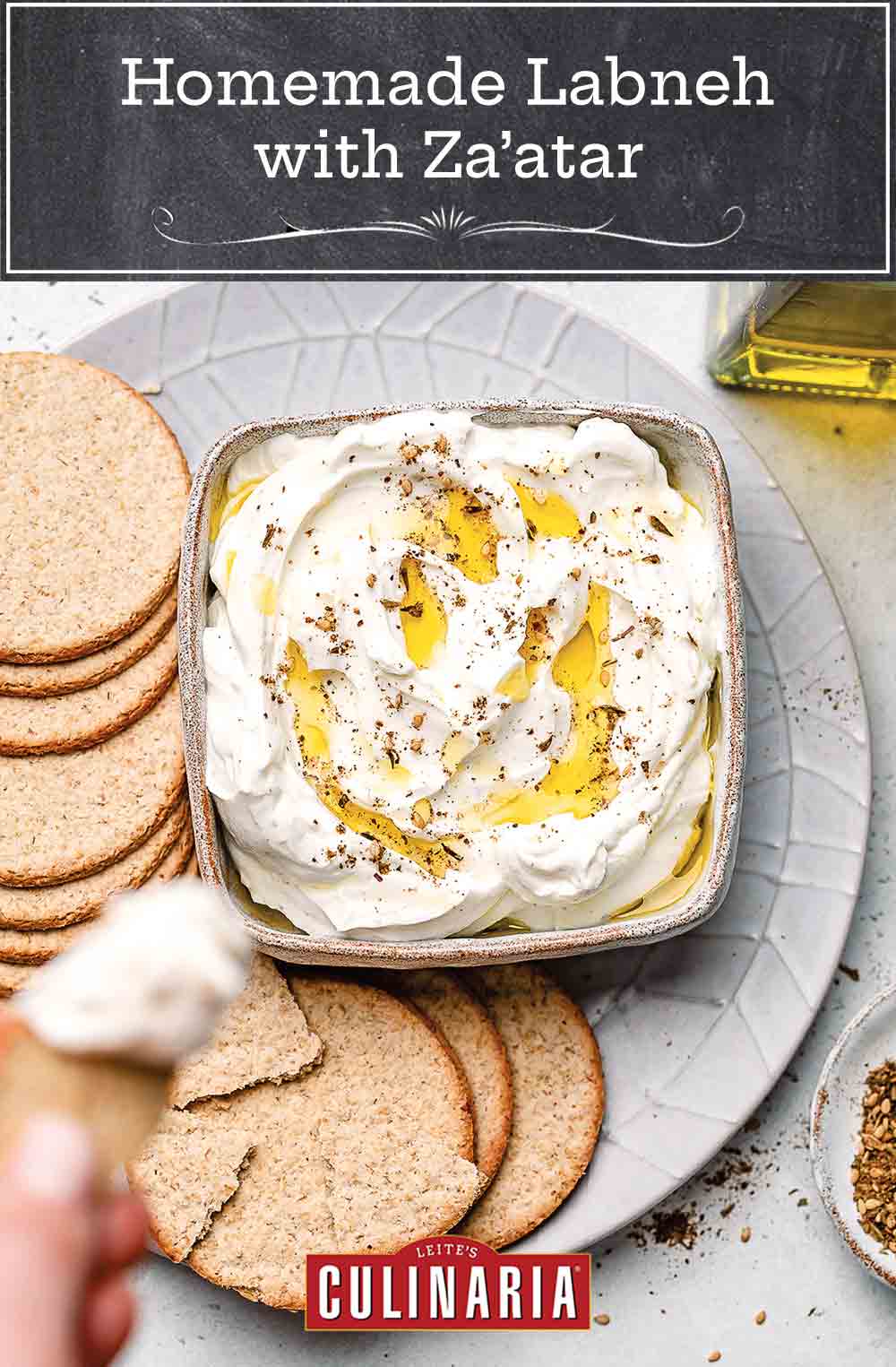





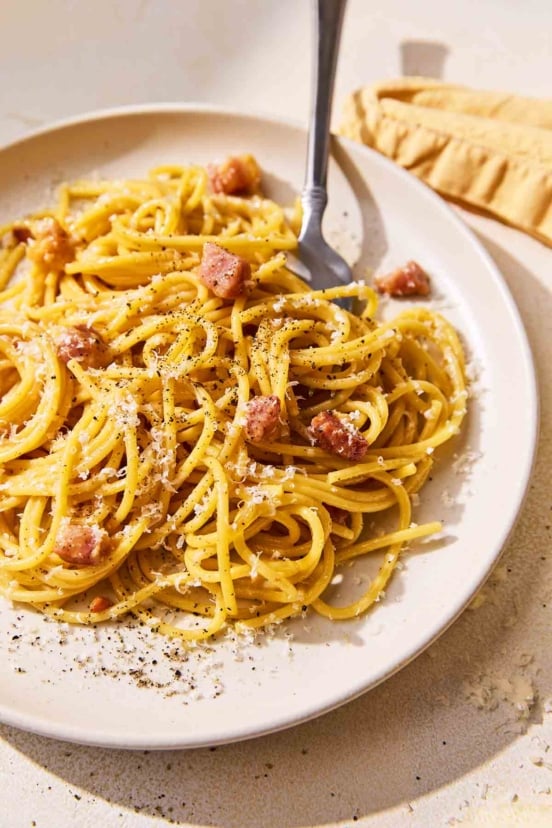

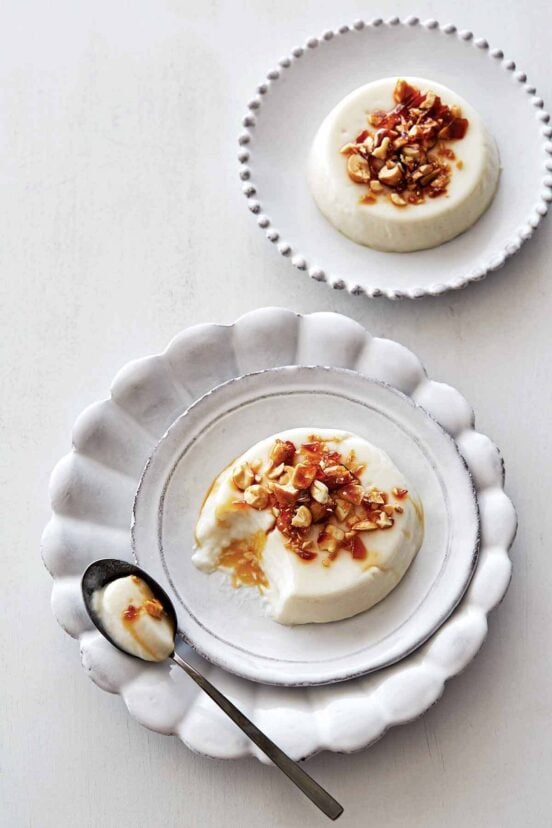









Can someone comment on using Chobani whole milk greek yogurt vs Fage whole milk greek yogurt. Their consistency is so different to start am wondering if those of you with good results used either of these brands to start. Thank you.
Denise, I don’t think any of our testers used these brands, but we’d love to hear from any readers that did.